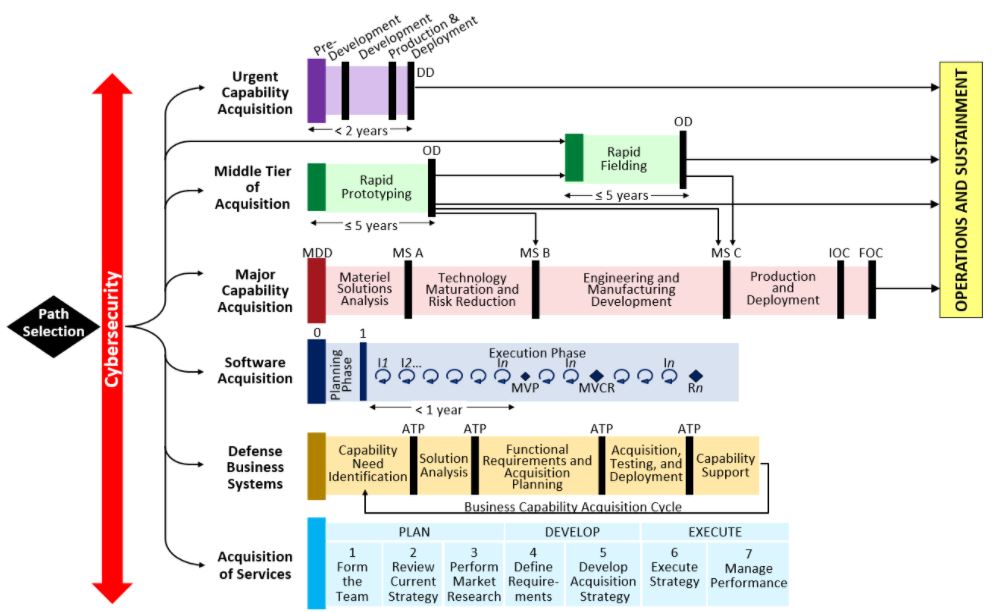DoD puts down serious money on 5G experimentation
The Defense Department is putting $600 million into 5G in five new military installations.
The DoD Reporter’s Notebook is a weekly summary of personnel, acquisition, technology and management stories that may have fallen below your radar during the past week, but are nonetheless important. It’s compiled and published each Monday by Federal News Network DoD reporters Jared Serbu and Scott Maucione.
Best listening experience is on Chrome, Firefox or Safari. Subscribe to Federal Drive’s daily audio interviews on Apple Podcasts or PodcastOne.
DoD expanding 5G experimentation with $600 million contract
The Pentagon is continuing its push to bring 5G to military installations and use them as testing grounds for new technologies.
The Defense Department announced $600 million 5G contracts for five new bases: Joint Base Lewis-McChord in Washington, Hill Air Force Base in Utah, Naval Base San Diego, Marine Corps Logistics Base in Georgia and Nellis Air Force Base in Nevada.
“Working in close concert with industry, we’re using these test sites to accelerate U.S. 5G leadership and ensure the department benefits the new applications enabled by this technology,” said Michael Kratsios, acting undersecretary of defense for research and engineering. “Moving forward, the department will continue to focus on large scale experimentation prototyping of dual use 5G technology for military and commercial purposes. The sandboxing activities on military bases harness the department’s unique authorities to pursue bold innovations in game changing technologies.”
DoD plans to begin testing at seven more bases next year.
Each base will have its own specialty. For example, Joint Base Lewis-McChord will “rapidly field a scalable, resilient, and secure 5G network to provide a test bed for experimentation with a 5G-enabled augmented reality/virtual reality capability for mission planning, distributed training, and operational use,” according to a DoD press release.
Other projects include building smart warehouses to improve naval logistics efficiency and improving command and control capabilities.
Industry partners range from AT&T and KPMG to GE Research and Booz-Allen Hamilton.
The bases will join 12 other installations where DoD is already fielding 5G.
“5G is going to be a game changer,” said Fred Moorefield, DoD deputy chief information officer for command control and communications. “One underpinning aspect of that is spectrum and how we share the airwaves with 5G and 6G and 7G what’s coming. In the department we will want more access. I think 5G will require an overarching overhaul of how we do business.”
The government is still wrapping its arms around 5G and its integration.
Back in March, the White House put out a strategy for the future of 5G in the nation. It outlined vulnerabilities and lines of effort to address risks.
However, a new report from the Government Accountability Office said the 5G strategy is lacking and that the Trump administration should have the National Security Council and the National Economic Council convene to remediate some of the issues.
GAO enumerated six desirable characteristics that the 5G strategy should have and found the White House only partially addressed each of them.
The characteristics include things like defining problems, goals and objectives, risk management and implementation.
GAO officials stated that the strategy does not properly manage the risk facing 5G in the United States.
“Strategy does not include a risk assessment or complete information on 5G risks and does not include information on the quality (constraints or deficiencies) of the data,” the authors wrote. “The strategy narrowly focuses on cybersecurity and supply chain risks to 5G infrastructure and does not include the full breadth of 5G risks.”
The report also stated that the national strategy does not discuss what the cost implementing the strategy will be or any estimates on what it will cost to achieve the goals outlined in it.— SM
New perks coming for moving service members
U.S. Transportation Command is no stranger to complaints from service members about the process of moving to a new home.
In fact, the combatant command is in the process of completely revamping its business structure for hiring movers to truck service members’ household goods.
But until that is settled, TRANSCOM is making some customer service adjustments it hopes will make moves a little easier for troops and their families.
The first is ensuring that the Defense Department protects its employees’ personal identifying information (PII).
Since this summer, TRANSCOM has been working with Customs and Border Protection and other DoD agencies to reduce the use of PII.
“Our primary goal is to eliminate the use of customers social security numbers, and then also reduce the potential exposure of other PII outside of government controlled systems,” Col. William Schoen, transition division chief at TRANSCOM, said last week. “We’re mapping the process to pinpoint exactly where PII is required. We’re also identifying the underlying policies and/or directives that drive the use of PII, and specifically looking for ways to modify or eliminate social security numbers.”
While that may save some potential headaches, TRANSCOM is working on more direct customer support as well.
TRANSCOM is in the process of establishing joint standards for counseling, meaning helping troops prepare for a move. That will be implemented in 2021. Later this month TRANSCOM will standardize the procedures for companies to follow.
Another topic service members may be happy to hear about is that TRANSCOM is expanding its personal property call centers.
“Each service has or will soon have a dedicated call center for customers that are seeking answers to personal property related questions or issues,” Schoen said. TRANSCOM also has its own number for assistance as well. “In order to improve the customers experience, and simplify the process, our offices are working on expanding the capability and capacity of 833-MIL-MOVE by increasing the quality of first contact with the customer, and then looking to add more hours of coverage.”
Other 2021 initiatives include better communication by providing additional time and notification before a shipment is delivered.
“We’ve asked the moving companies to document two unsuccessful attempts to contact the customers before putting goods into storage,” said Col. Marshanna Gipson, deputy director for operations at TRANSCOM’s Defense Personal Property Management Office. “We’ve has situations where the family is still in transit and not able to sign off.”
TRANSCOM is requiring movers provide residential protections against property damage like putting down floor coverings. Also, if items are destroyed, lost or damaged then customers will be able to choose if they want the item replaced or repaired. They can choose just to get payment for the repair cost so they don’t have to hang on to damaged items.
“A lot of customers are holding on to things like a broken washing machine,” Gipson said.
TRANSOM is also requiring companies to put tamper-proof seals on all containers. — SM
5000 series cybersecurity policy to come soon
The Defense Department has been releasing its overhaul of the 5000 acquisition series by piece mail during Pentagon procurement chief Ellen Lord’s tenure.
Now that most of it is available to the public — including the most recent broad overview, which Deputy Defense Secretary David Norquist signed last month — DoD is putting out a broad policy on cybersecurity that will touch every part of defense acquisition.
“This new policy, which we expect to be signed out later this month, ensures cyber hardening is designed in at the beginning of a program, and ties in closely to our Cybersecurity Maturity Model Certification (CMMC),” Lord said last week.
Cybersecurity is supposed to be baked into acquisition programs and considered in all aspects of procurement and development.
The CMMC is a guideline companies must follow to work with DoD that include cybersecurity standards and supply chain requirements.
The new cybersecurity policy will be spread throughout the whole 5000 series, touching everything from major acquisitions to mid-tier acquisition to software to rapid development.
The 5000 series overhaul has six tracks, all moving at different speeds with different requirements and oversight. The hope is that each track will be tailored to the needs of each product. For example, software needs to be updated much faster than a tank and therefore the procurement process is different.

As for the future of the 5000 series, Lord said it is a work in progress.
“From the onset, the series was designed to be a living document to provide our defense acquisition system with an adaptable responsive foundation capable of satisfying emerging requirements,” Lord said. “We are focused on ensuring we provide the right tools to deliver end to end operations, operational capability and we are exploring the creation of additional acquisition pathways to address unique systems. For example, the department is working with the Space Force to determine whether there are any tools missing and is committed to developing a tailored space vehicle pathway, if needed.” — SM
Copyright © 2025 Federal News Network. All rights reserved. This website is not intended for users located within the European Economic Area.
Scott Maucione is a defense reporter for Federal News Network and reports on human capital, workforce and the Defense Department at-large.
Follow @smaucioneWFED





